Episode #427: From Math Overload to Alignment: A Mentoring Moment for Leaders
LISTEN NOW HERE…
Leading math professional learning in a large system is never simple — especially when every school wants something different. How do you support meaningful math growth without burning out or losing focus?
In this Mentoring Moment episode, you’ll hear a real coaching conversation with a math learning coordinator who’s navigating a new team, an ambitious vision, and a calendar full of math PD that feels more reactive than strategic. Together, we explore how to shift from disjointed math initiatives to a more coherent system built around one clear goal. If you’re supporting math teams, planning PD, or trying to bring focus to your district’s math work, this episode offers a practical entry point.
In this episode, we unpack:
- Why narrowing your focus in math professional learning leads to greater impact
- How to guide school teams to choose aligned math goals — without losing autonomy
- What it looks like to connect your math vision to day-to-day teacher support
- How to use learning cycles and coaching touchpoints to strengthen math instruction
- The questions math leadership teams should be asking — but often don’t
Whether you’re a math coach, learning coordinator, or system leader, this mentoring conversation is packed with insights to help you bring clarity, coordination, and momentum to your math improvement efforts.
Attention District Math Leaders:
Not sure what matters most when designing math improvement plans? Take this assessment and get a free customized report: https://makemathmoments.com/grow/
Ready to design your math improvement plan with guidance, support and using structure? Learn how to follow our 4 stage process. https://growyourmathprogram.com
Looking to supplement your curriculum with problem based lessons and units? Make Math Moments Problem Based Lessons & Units
Be Our Next Podcast Guest!
Join as an Interview Guest or on a Mentoring Moment Call
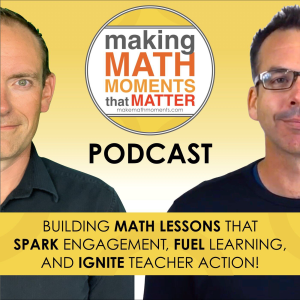
Apply to be a Featured Interview Guest
Book a Mentoring Moment Coaching Call
Are You an Official Math Moment Maker?
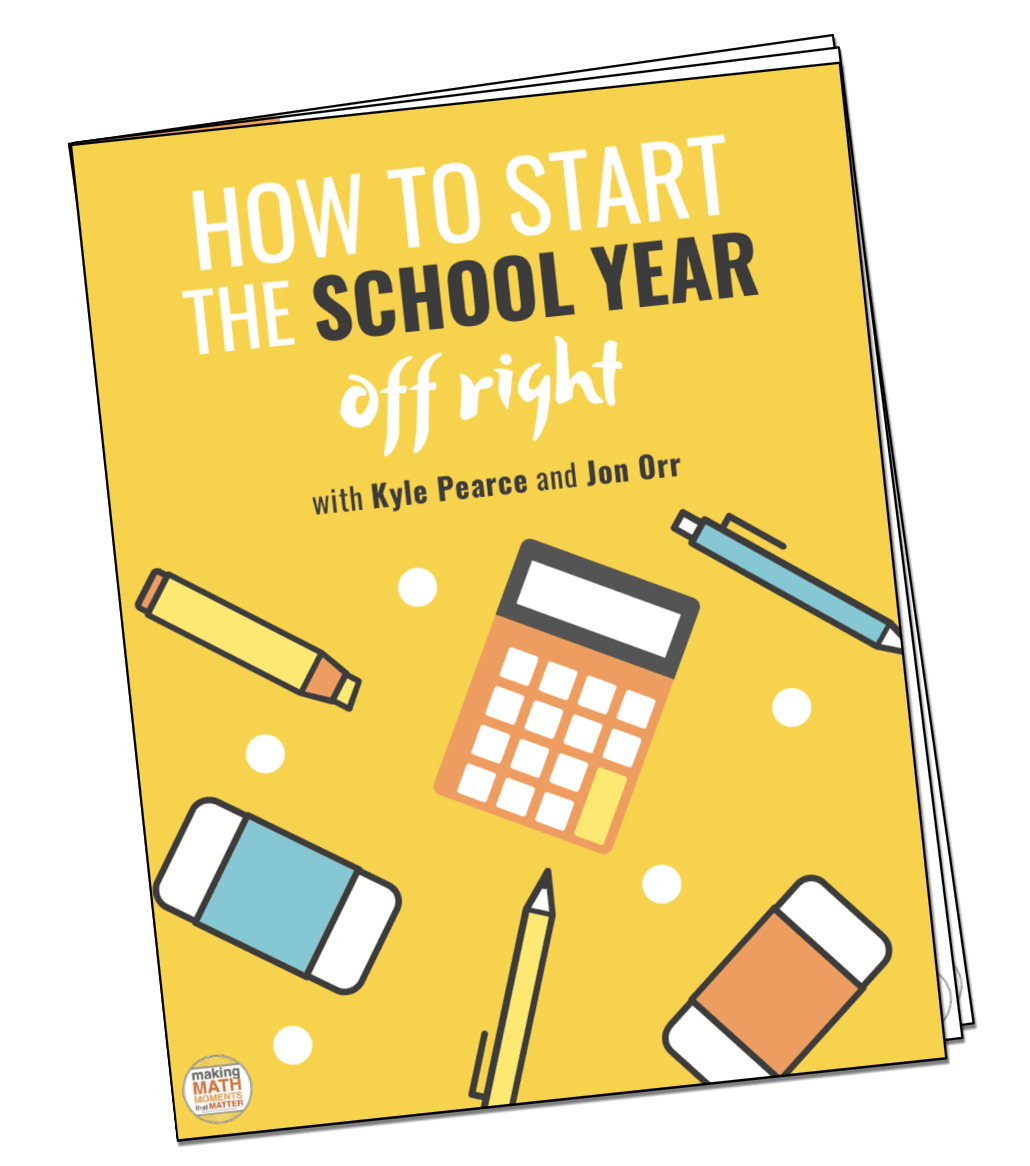
FULL TRANSCRIPT
Hello! How are you?
I’m pretty good.
Well, fill me in. I know I got your messages about the work that you’re doing, tell me in live time what’s going on.
Yeah, math, we’ve got our vision. So know the student, know the…
do you want to begin?
the content and know that like high impact strategies. we kind of framed it out and it nice visual and we’ve had some sessions for admin for staff. And those are more centered around scope and sequence. So we’ve developed what that looks like for our board. And this is very new for staff. was like a draft format last year. So that’s kind of like the first year it’s officially underway.
and we’ve had like positive feedback yet there’s still like lot of learning to be done. And that pulls in like check-ins, like pre and post check-ins and using that data to inform instruction and using KnowledgeHook as an online digital tool so that students are also using like exposed to kind of the EQAO format. So we’re just kind of like building all of those pieces in so kids are used to it.
and using that data to inform instruction. So how am I getting the feedback and how am I applying it? So all these pieces are kind of like coming together. It’s kind of like how to drive that ship as a team because yes, we can offer like a pullout PD after school, but what’s more like intriguing to me is like how to partner with those school teams or how to run like a learning cycle with them.
So yeah, I was just looking to kind of connect around like those types of ideas and what the opportunity could look like to have like a focused support on like those pieces, because if we’re not prioritizing like that bird’s eye view of the board moving together, that we might just kind of fall into that like, okay, we’re just running afterschool sessions with PD. Like where’s the real work?
And I’m trying to highlight that, want some more, yeah, strategy around that.
So it’s, sounds like there’s, so there’s a lot you wanna do, but there’s a lot of pieces. And it sounds like what you’re saying is, I’m not sure yet how to align the pieces up. Yeah.
Yeah.
I feel clear. I’m grounded in what my work, how I want to spend my day. But other people, feel I’m hearing them that they’re overwhelmed or there’s so many tasks. And I’m not a tasky. I don’t want to start at tasks. want to start at what’s our plan so that we know what the tasks will be. But we need like this I prompt, I message you because
yesterday at our meeting, was like, here’s the calendar for November and December, put all your events on it. And I was like, you know, I don’t want to do like, what is our plan? So we know what the events we need are. I just thought it was very interesting that like, we were going into the tasks rather than like, mapping out our year type of thing. So I’m treading lightly, okay.
what’s the one thing that you want to see improved? Let’s just say small right now, like short term by the end of even the years of long-term. it’s like, what’s one thing by the end of the year, you’re like, this is, if we only could do one thing, this is the thing that I would do. Like the focus, the, you know, the, the, the, the, achievement you want to see.
I think it’s.
Right? So like, cause you’re not saying like, these aren’t the tasks I’m going to do. What’s the result I want to achieve.
Yeah. So based on each school, they’d have a math action plan. So I think it has to be kind of school based, which is like, I had to learn a bit about that too. Like is it our board choosing a math process that we are focusing on or is it school based? So it looks like it’s school based, like, okay, we’re focusing on small group instruction and representation, representing. So I think for me, it would be being a school,
Okay.
And C, this is a learning cycle. Are we seeing students improvement on this outcome? And what is the teacher action linked to that? So I’m thinking teacher action, student outcome, and how is there growth and like having multiple, like that flywheel and trying that. That would be like my thing. It’s like we tried it and we could see student outcomes.
Okay.
Do you think the schools can choose anything they want?
It’s broad.
Right. Do you think that they are?
They are best positioned to choose.
Like, this is probably the principle of choosing, right? Yep. So like, because this is.
Not really, like I don’t wanna say like, okay. Yeah, I do really know, but like they’re in the building and yeah.
Yeah, they’re all great people, right? they’re all, but it’s, so what happens, right? Is like, because it’s broad and you’re supporting this and you’re, you’re going to be boots on the ground to help bring this math action plan to life at the school level, because you’re a coordinator, math learning coordinator for mathematics. Like it’s, you’re a coach, you know, all these things, right? So it’s.
So what happens is that it’s gonna be hard for you to kind of pull resources. And as a system, what you want is you want a little bit more narrowed focus so that yes, there’s autonomy at the school site to choose their action plan, but what we would rather and what we would recommend is that the district or the board sets the what. But the school can choose the how, but they’re gonna pick within the what’s.
Is that what you think you have set up right now? Because you’re saying we’ve got the know the student, know the content, know our strategy, which is kind of like the big ideas, but it’s like, what am I doing at the school site to strengthen one of those three things right now?
Yeah, it seems like it’s a school site thing. And I do wonder about like picking one so that it is the same, but I don’t know if that’s a consideration or on the team’s radar, like the math team’s radar, that idea. Right.
It’s like, it’s not necessarily that you pick one and then all schools have to do it. It’s just saying like, which here’s a selection that we can support. And we would encourage you to support. wouldn’t support. Which one of these do you want to do? So that you can now coordinate because all of a sudden, if you’ve got two schools doing the same thing, you can coordinate your support across two schools and not go every school has chosen something completely different. And actually our
Okay.
our core resource doesn’t even support that. And it’s like, now I have to collect resources over here that didn’t exist before. And it’s maybe not actually geared towards the work that you know is important for the school because you’re in a position to assess that, what learning at the professional development level needs to happen in that building. There’s lots of teams that have gone about this different ways where they’re saying like, here’s our three things.
But now if you were going to choose, you also need coaching at the school site to choose the right thing and focus on the right thing. So some of our teams who are at the board level have made it a point to say, by the end of the year, if I can have each school site and therefore the administrators create an action plan that is actually manageable and
is in the right area of where we want to see improvement according to our three objectives and our mission and our vision, that is our one thing. Which means all of our work at the team level is now to help administration set their action plans and build their action plans and pick their goals and pick the measurables and go, are we measuring the right thing? Is knowledge hook the right tool here to use? Now that we know that this is the one thing at the school site, now we can go,
Let’s get the ducks in a row. Now let’s go, okay, well, if that’s the one thing that we’re gonna strengthen here at the school, what does the school site look like in terms of the pieces? Staff meetings, what are we doing in staff meetings to, because that’s our like top level, you know, we always have staff meetings and everyone’s there, but then it’s like, do we have grade level team meetings, which is one step more narrow? Are we influencing that? How can we influence those? Those are the, it’s not what should we do, it’s how could we do it?
And so you can’t, we can’t do it with that team because that team doesn’t have any overlap in grade levels, you know, or there’s no way that we can get release time for that teacher to go over to that teacher’s classroom. So it’s like, but that grade level looks like there’s coordination over there. But then it’s like, what are we doing to coach? Like that’s another option that we have, like, but it’s all about the one thing for that, for that school. So it’s almost like you’re developing this, this continuation, this roadmap, aligning all the pieces, but, it’s helping.
each team pick the one thing and how you’re going to measure that one thing by the end. This is why we always encourage one thing because what you want to do is map it all out for one thing and then go, do we have time and space to do something else? If not, then that’s it. Right? So it’s like, if you’ve got all these schools you’re supporting and I’m going to help this school pick one thing and then I’m going to help them develop what the support looks like to see this achievement by the end of the year.
And because I think you ought to define that. I seeing, I looking, obviously we want student, like there’s no question you want student growth to happen, right? But what you want to get narrow on is what do I want teachers classrooms to look like? Or what do I want teachers learning experience to be this year? And that is kind of how you want to map out what are the touch points we can put into place to create that experience across the system.
So now when we have our full day, numerous CPD, you know, in June or something, whenever everyone comes together because they picked within the category, you can now strategize and coordinate that work. Yeah.
I wonder if what we’re choosing, for example, everything’s revolving around scope and sequence. Our new tool where curriculum is now mapped out so we have a unified experience for what map, in terms of what is being taught. And then inside of it is high impact instructional practices and math games and math vocabulary, so chunks. So it’s a lot of things. And I’m wondering,
is that I think what’s happened is that that is the one thing because everything lives inside the one thing but it’s almost like too big I don’t know
You’re saying like, my one thing is that I would love to see, because we’re making a scope and sequence and that there’s a resource there for teachers and the resources tied to providing the experience we wanna see in our classrooms, which is tied to our vision that by the end of the year, if I could have more teachers following the scope and sequence effectively, then I would be extremely happy.
Yeah, that’s what it’s saying.
Right, and then now it’s, well, how do I do that at the levels and then the access, which means like, how do I support an individual site to do that? And how do I, what are my touch points to do that? And then you’re coordinating your support, but really all you’re doing is you’re helping teachers take the lessons that they have with the mapping, the scope and sequence you’ve created, the resource that they have and.
and help them structure their lessons, deliver their lessons that actually are aligned to what that lesson was originally intended to do. That can be impactful because as long as you believe that the resource is completing your puzzle, and then you can say that, because every lesson is different, but I think what you wanna get to is go,
Can I create a narrowed support approach? Like where do we, where’s our limits? You where’s our, our own time limits on the work that we could be doing because every teacher needs four things. Like even if I said, like, wish want more teachers to have support understanding what this lesson big idea is, why these pieces of this lesson are important and, what the mathematics that is unpacking here, like what’s the big idea of the mathematics here.
so that they can teach this lesson confidently and flexibly. And then next year they can teach it even more confidently and more flexibly. Then you have to say, well, how many touch points, like, cause teachers need understand, they need to be able to see it in action. They need to be able to have their like, feel like this is doable in their own room, but they also need that continued follow-up support. Whereas there’s multiple touch points across the teacher. Otherwise you’re still surface level skimming, which you won’t see any growth by the end of the year that way.
You’re not going to see overall growth by the end of the year, but if you can get narrow to say like that teacher or those five teachers I’m going to partner with for the year, those five teachers I’ll see growth in. And then next year it’ll be two of those people and three more. And then two of those people and three more, and then two of those people and three more. That’s how you can kind of scaffold your way across, you know, seeing what you want to see because you narrowed your focus that way.
Right.
So it’s just about kind of what are those levels of support? Once you know, hey, this is what the work’s gonna look like and this is why we’re doing that type of work. And then go, what are the levels of support? how do, like, if all of a sudden there’s like a PD day that we know is coming up and I’m like, wait a minute, I’m not scheduled to run that PD day, but who is? How do I, like that becomes a focus of work, right? It’s like, it’s on the agenda. Well, how do I help them?
or help myself utilize that to get our message across or our information that’s tied to the one thing.
Okay. Yeah. And I wonder if that like, I guess it, I don’t know what happened with like the whole task bit like mapping things on a calendar without considering like, where do we want to go? Yeah, so
Yeah, like I would bring the team back together. If you don’t feel like the team has a clear puzzle in mind, then you need to kind of bring that back to focus. Like, hey, let’s all understand again. Could we all write down what does five years look like for now? If we could say that there’s only one important zone of improvement, what is that one zone? And do we all agree?
clear.
I
It sounds like you’ve got those zones, but it sounds like you’re also saying we don’t understand what we’re really trying to do here
Yeah, so I’m like, that’s why I thought a check in would be helpful because I’m thinking, am I crazy for not feeling that it’s being heard? Like, if are we mapping things out when we don’t actually know what we are planning for? So
Because if you do have say your vision and you do have say some objectives, you just have to say like, does it pass the filter? If I’m putting things on a calendar map, we have to be able to justify that that thing supports it, but how? And how will I know it’s support? Like how does it know it improves that one component? Like if you can’t say this action supports this zone of improvement or this focus,
and here’s exactly how I know I will see in traction or impact, then you have to question whether you should be doing that or not. Because you’re not measuring that impact or seeing the success. Like measuring can be a million different things, but you still have to think about it. You have to say, write it down, share it to a partner. Here’s exactly why we’re doing this and here’s the impact I should see by it. And it’s important because otherwise you could say like, well, why wouldn’t we do something else?
to get the same impact for less resources or less time. That’s why you go through that process.
Okay. So I also think it includes like looking at what our roles are and how we support the system too. Because is it like leading admin, is it leading a small group of staff? So there’s like super, a lot of opportunity there to get more clear. And I think there’s a lot of uncertainty and like knowing because it is a new role in a new kind of team, but like, this is the work, right? This is like how we figure it out.
And that’s where I need your brain because that is like, if they’re trying to figure it out, then like, yeah, we need to move in the right directions together here.
back to the board.
Yeah. What’s your next step?
I don’t know. Yeah, I guess I’m looking for feedback too from you. Like, do you see this fitting in any way to what kind of your team could support with or yeah, how is this landing?
Yeah, like I think there’s, always partner with teams that are speak the same language and they know they’re after the right things. And what we are doing is we help those teams get aligned in the processes that, sometimes the lessons that everyone needs to understand or learn so that they can move towards the right way, like the right things. So we very much try to create those conditions for teams.
to have the right thinking points, the right thought exercises, the right activities, to get on the same page, to align the actions, to achieve the intended results, but then to measure the right things. then we help with the implementation of those things. What does that look like on a PLC level? What does that look like at a staff meeting? What does that look like in the emails and nuggets of information you want to drip out over time? How do you coordinate all of that? Are there to guide that process?
So that’s what we support into this type of work. So we have different levels of support. I probably shared them with you last time. So in a way, that’s kind of the support we can provide is when a team’s like, I know this is important, but I don’t know exactly the roadmap to do it. Well, we can provide the roadmap and the guidance along the road and the support along the road, but we only do it when teams go like, that’s what we want.
Mm-hmm.
That’s what we need to do because it doesn’t work if there are not say individuals that are like, that’s the work we wanna do.
And I guess that is why, yeah, I’m feeling a little bit like, is this the work that we wanted to do? like, Am I the only one thinking about it? And that’s why I
It’s likely you are because it’s not like this like epiphany that you typically or this preconceived or this pre understanding that you have when you step into these roles. Most of us are classroom teachers that have been doing work by being great teachers and having great lessons. And then we step into supporting roles and then we’re like, hey, here’s a whole program that you now need to develop and support. Make change, make improvement.
but we’re not sure exactly how to do it. So we’re just gonna keep doing good stuff. We’re just gonna keep, hey, that worked in my classroom, let’s try it here, because that’s the way that we learned for our kids. Like we would trial and error, and then we would say, hey, that worked or that didn’t work. But then when we, we only worked in our bubble, and we don’t have the systems knowledge and the team dynamic understanding to kind of transfer. then, so we learned that in the job, like you’re going to learn it. It’s just how fast do you wanna like,
learn it and apply it. So sometimes it’s like, it’s, you’ve obviously had the epiphany that that’s important and, seeing like, we could be doing this in a more streamlined approach to work faster and easier. Not everyone has had that epiphany yet, right? So sometimes it’s like sharing a knowledge with other people or, or having them show up to a session, you know, or meeting or, can help them see that epiphany when we ask the right questions.
I have a document I can share with teams, like I’ve been sharing with teams lately and I don’t know if I shared it with you, which was basically how do you talk about this type of thing with other people?
Yeah, that is totally where I’m at. think like I was like awareness is kind of like first up here.
Like awareness, like, hey, we’ve been doing this this way. And actually like, here’s a question that we all need to answer. We actually don’t have a good answer for this. So that’s what the document is. It’s like, how do we do this? And how do we think about this? And what could be you doing here? So I can share that with you after the call for sure.
Okay, I appreciate that. Well.
Yeah.
So that’s your next step is to maybe read that and then go like, had our next team meeting. Maybe I’m going to ask some of these questions about like, what, what does this look like? And what are we, what are we trying to do again? And do we have like, like, let’s get the vision on the table because we have to be able to answer this one question at the end of the year, which is like, when we get there, what were the things we, we did for impact on this? Not that, not all this, just this.
These zones of improvement, these three things that we pointed out were essential. Okay, which are like these are from the ministry, but what are the things that we did to impact each of those zones? And how do we know we did it?
Mm Yeah. And that is big like that. Let me think for a second.
But when team answers that, that’s when the alignment starts to happen, right? That’s when the coordination starts to happen as it forces you to think about, okay, well, let’s just start with one thing at a time. Like if I really want to see traction on what? Like what do we want to see traction on? Is it a teacher practice? it a, maybe it’s a math concept that we want to strengthen because we know that our data is actually saying that from our standardized test results. We’re like, we just need to strengthen this up and therefore we need.
more understanding with our educators on the behaviors of this mathematics and the models or the strategies we be using just for themselves. Like that might be the focus to move forward on. But when we know it, now we start to like, what are the models or the channels we have access to and how do we coordinate those channels to get closer to that goal.
Mm We have chatted about like, what is what did we do? How well did we do it? And are we better off like these are that is kind of part of our conversation and in presenting and connecting with admin in terms of math and our school improvement and equity planning. So it is there but the disconnect for me is like, our team isn’t say planning like, what are the things that we are doing? Like
as a leadership team, I guess, to see how that impacts the system. So I’m just like itching to like meet about how our we’re interacting with the system, because yes, maybe we’re coaching school teams to consider these things, but also like how does it fit from here so we can support in a way too.
Okay, do you have a next step now?
Yeah, so the document, hopefully that can give me some somewhere to start with like that system knowledge and how it lands in coordinating like the leadership piece and yeah.
Okay, we’ll make sure you have that and how do you feel now?
I’m more confused. just like, okay, I hopefully on a track. Like, at least I kind of have awareness as to like, okay, I need to spark awareness and like keep keep talking about the things that I’m noticing.
Got it. All right. Awesome. Well, thanks for taking the call today.
Yeah, thank you too.
Before we go, I asked you your next step. What was your big takeaway today?
Okay,
choosing one thing is conducive to providing direction. Yeah, choosing one thing in terms of like improving, whether you’re at the school level or the board level, it’s helpful to choose one thing.
That’s a message I think we hope most of our listeners hear is that sometimes choosing less is more. You hear that phrase all the time, but we really have to try to live it. It’s just hard. All right, we will talk soon and looking forward for updates.
Okay, sounds good. Thanks for. Yeah, bye.
Thanks for meeting today.
Thanks For Listening
- Book a Math Mentoring Moment
- Apply to be a Featured Interview Guest
- Leave a note in the comment section below.
- Share this show on Twitter, or Facebook.
To help out the show:
- Leave an honest review on iTunes. Your ratings and reviews really help and we read each one.
- Subscribe on iTunes, Google Play, and Spotify.
DOWNLOAD THE 3 ACT MATH TASK TIP SHEET SO THEY RUN WITHOUT A HITCH!
Download the 2-page printable 3 Act Math Tip Sheet to ensure that you have the best start to your journey using 3 Act math Tasks to spark curiosity and fuel sense making in your math classroom!
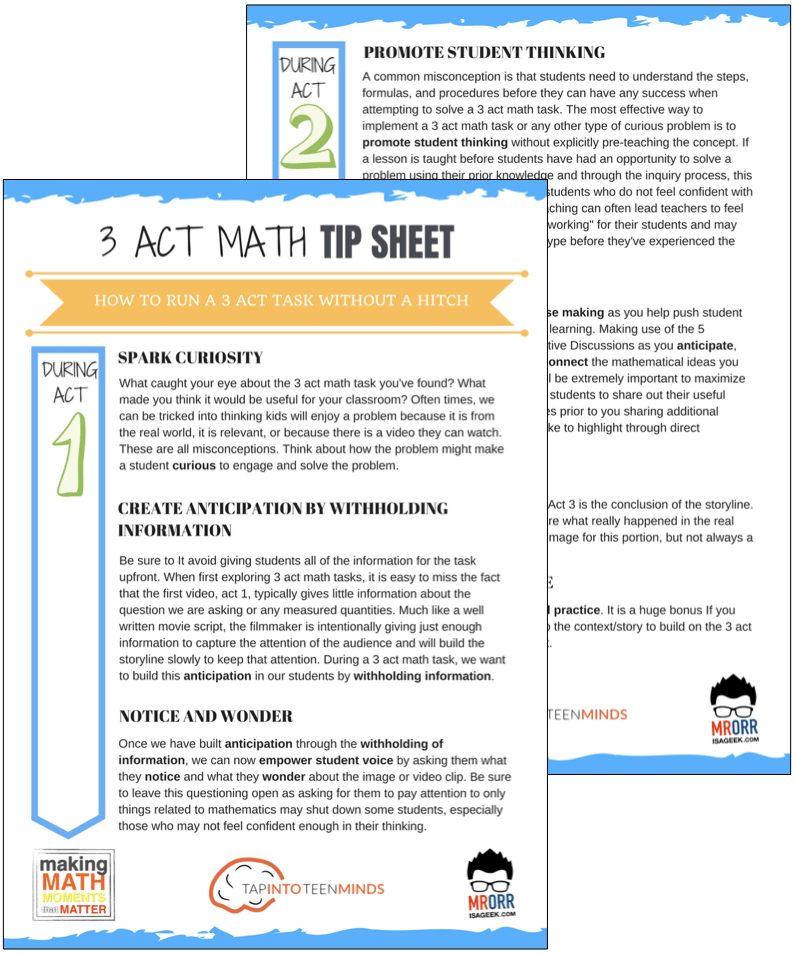
LESSONS TO MAKE MATH MOMENTS
Each lesson consists of:
Each Make Math Moments Problem Based Lesson consists of a Teacher Guide to lead you step-by-step through the planning process to ensure your lesson runs without a hitch!
Each Teacher Guide consists of:
- Intentionality of the lesson;
- A step-by-step walk through of each phase of the lesson;
- Visuals, animations, and videos unpacking big ideas, strategies, and models we intend to emerge during the lesson;
- Sample student approaches to assist in anticipating what your students might do;
- Resources and downloads including Keynote, Powerpoint, Media Files, and Teacher Guide printable PDF; and,
- Much more!
Each Make Math Moments Problem Based Lesson begins with a story, visual, video, or other method to Spark Curiosity through context.
Students will often Notice and Wonder before making an estimate to draw them in and invest in the problem.
After student voice has been heard and acknowledged, we will set students off on a Productive Struggle via a prompt related to the Spark context.
These prompts are given each lesson with the following conditions:
- No calculators are to be used; and,
- Students are to focus on how they can convince their math community that their solution is valid.
Students are left to engage in a productive struggle as the facilitator circulates to observe and engage in conversation as a means of assessing formatively.
The facilitator is instructed through the Teacher Guide on what specific strategies and models could be used to make connections and consolidate the learning from the lesson.
Often times, animations and walk through videos are provided in the Teacher Guide to assist with planning and delivering the consolidation.
A review image, video, or animation is provided as a conclusion to the task from the lesson.
While this might feel like a natural ending to the context students have been exploring, it is just the beginning as we look to leverage this context via extensions and additional lessons to dig deeper.
At the end of each lesson, consolidation prompts and/or extensions are crafted for students to purposefully practice and demonstrate their current understanding.
Facilitators are encouraged to collect these consolidation prompts as a means to engage in the assessment process and inform next moves for instruction.
In multi-day units of study, Math Talks are crafted to help build on the thinking from the previous day and build towards the next step in the developmental progression of the concept(s) we are exploring.
Each Math Talk is constructed as a string of related problems that build with intentionality to emerge specific big ideas, strategies, and mathematical models.
Make Math Moments Problem Based Lessons and Day 1 Teacher Guides are openly available for you to leverage and use with your students without becoming a Make Math Moments Academy Member.
Use our OPEN ACCESS multi-day problem based units!
Make Math Moments Problem Based Lessons and Day 1 Teacher Guides are openly available for you to leverage and use with your students without becoming a Make Math Moments Academy Member.
Partitive Division Resulting in a Fraction
Equivalence and Algebraic Substitution
Represent Categorical Data & Explore Mean
Downloadable resources including blackline masters, handouts, printable Tips Sheets, slide shows, and media files do require a Make Math Moments Academy Membership.
ONLINE WORKSHOP REGISTRATION
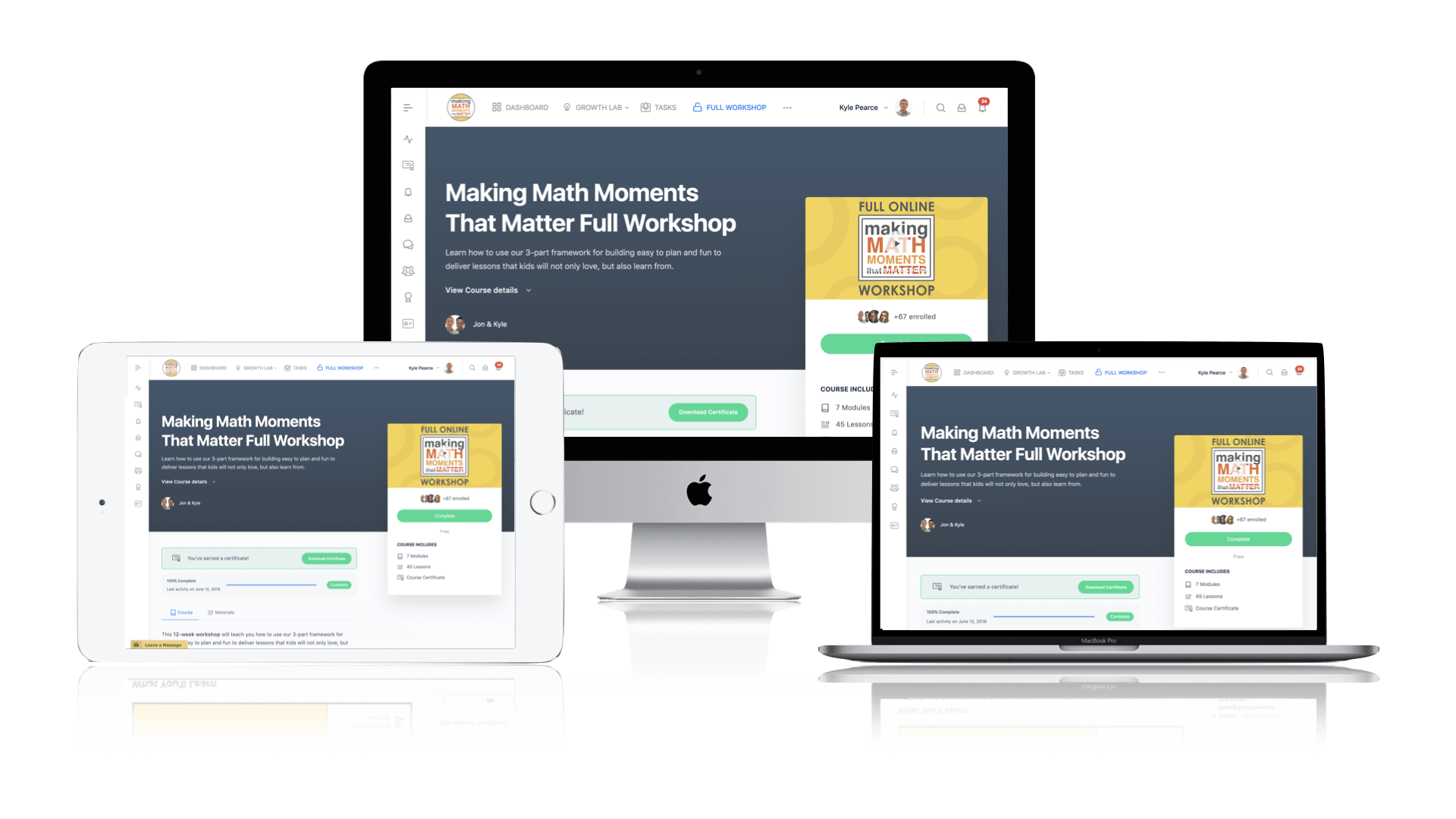
Pedagogically aligned for teachers of K through Grade 12 with content specific examples from Grades 3 through Grade 10.
In our self-paced, 12-week Online Workshop, you'll learn how to craft new and transform your current lessons to Spark Curiosity, Fuel Sense Making, and Ignite Your Teacher Moves to promote resilient problem solvers.
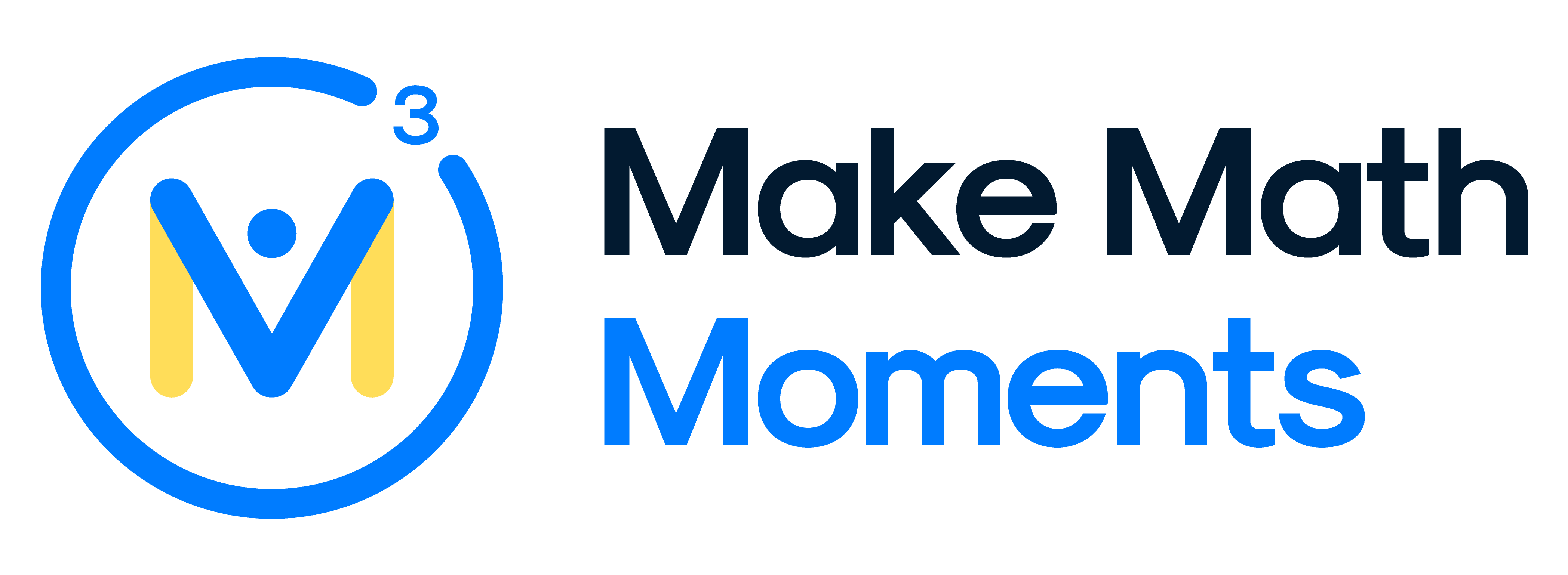



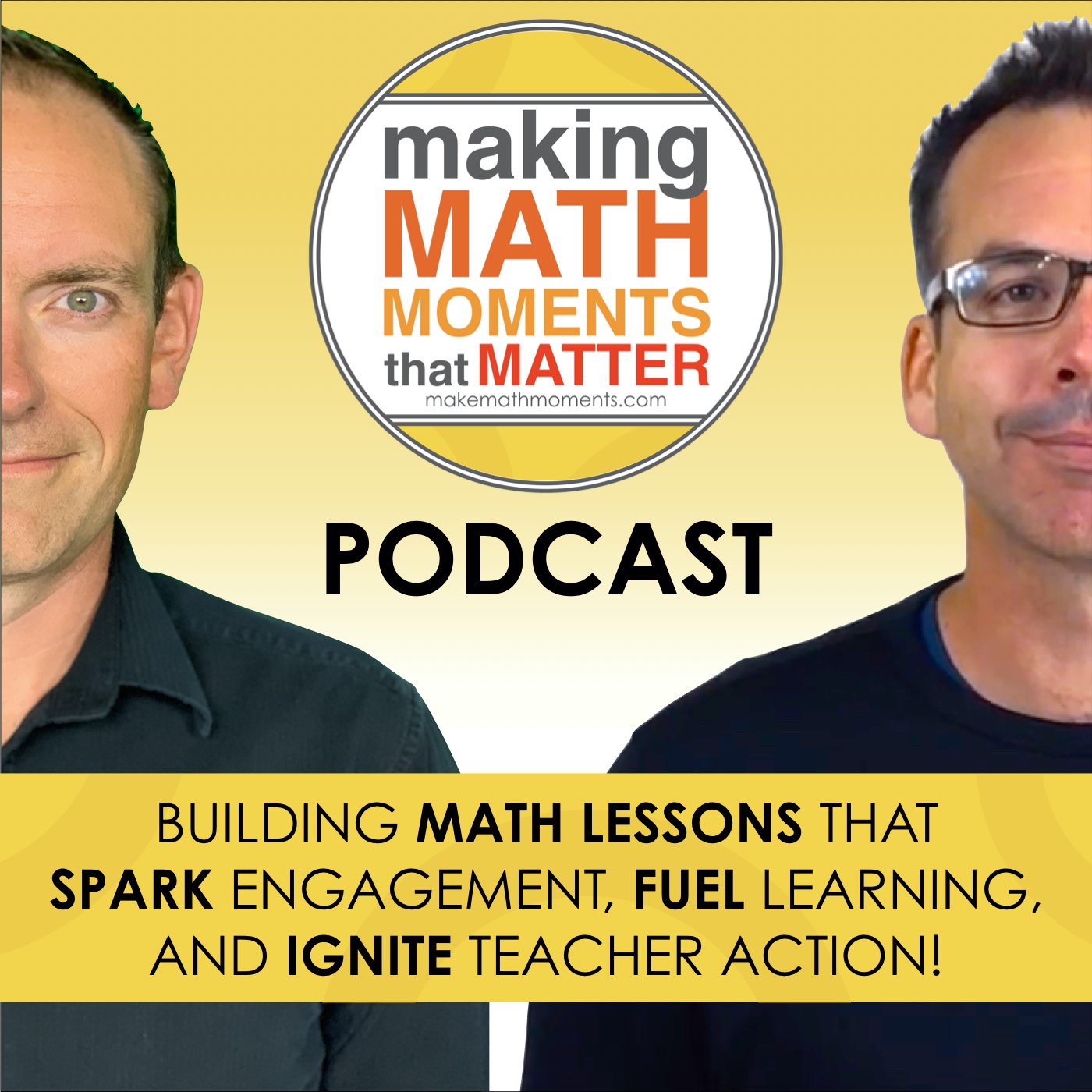

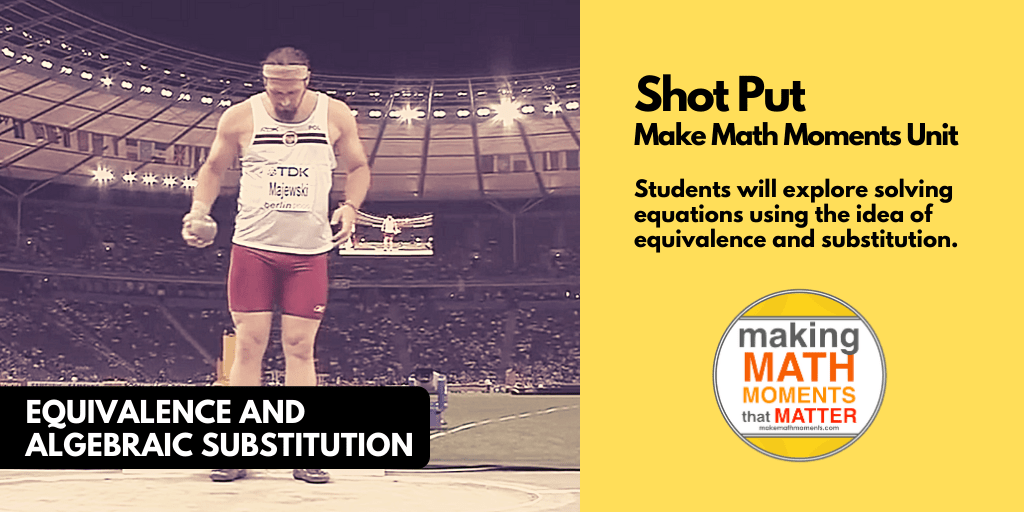
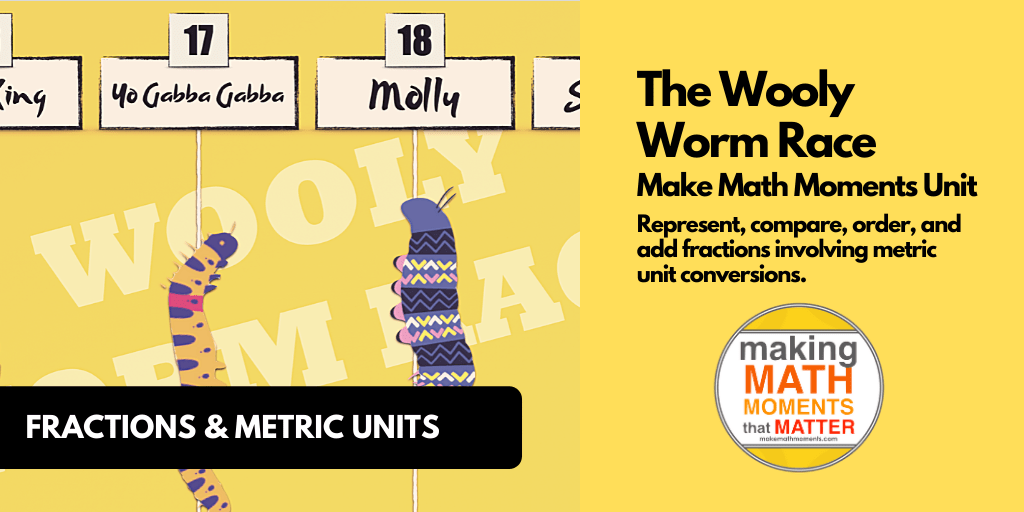
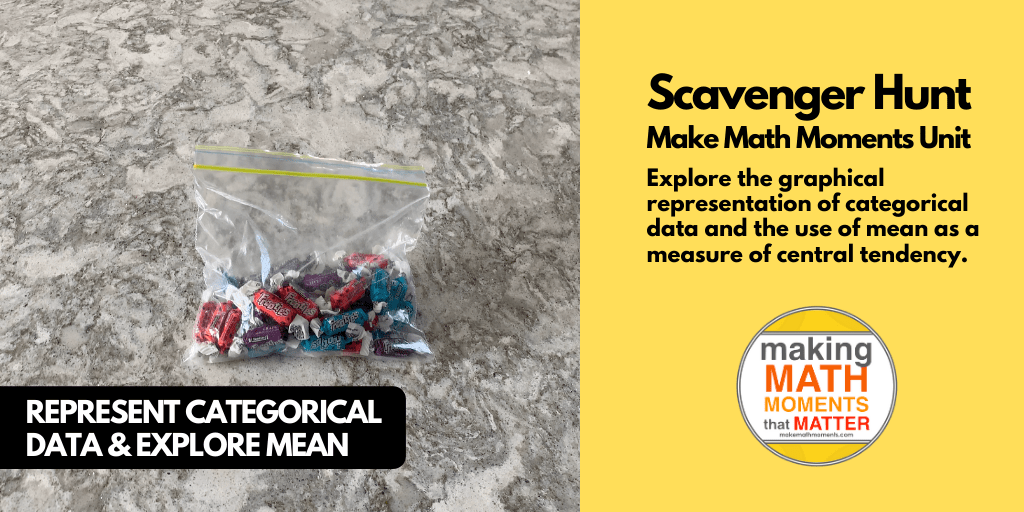
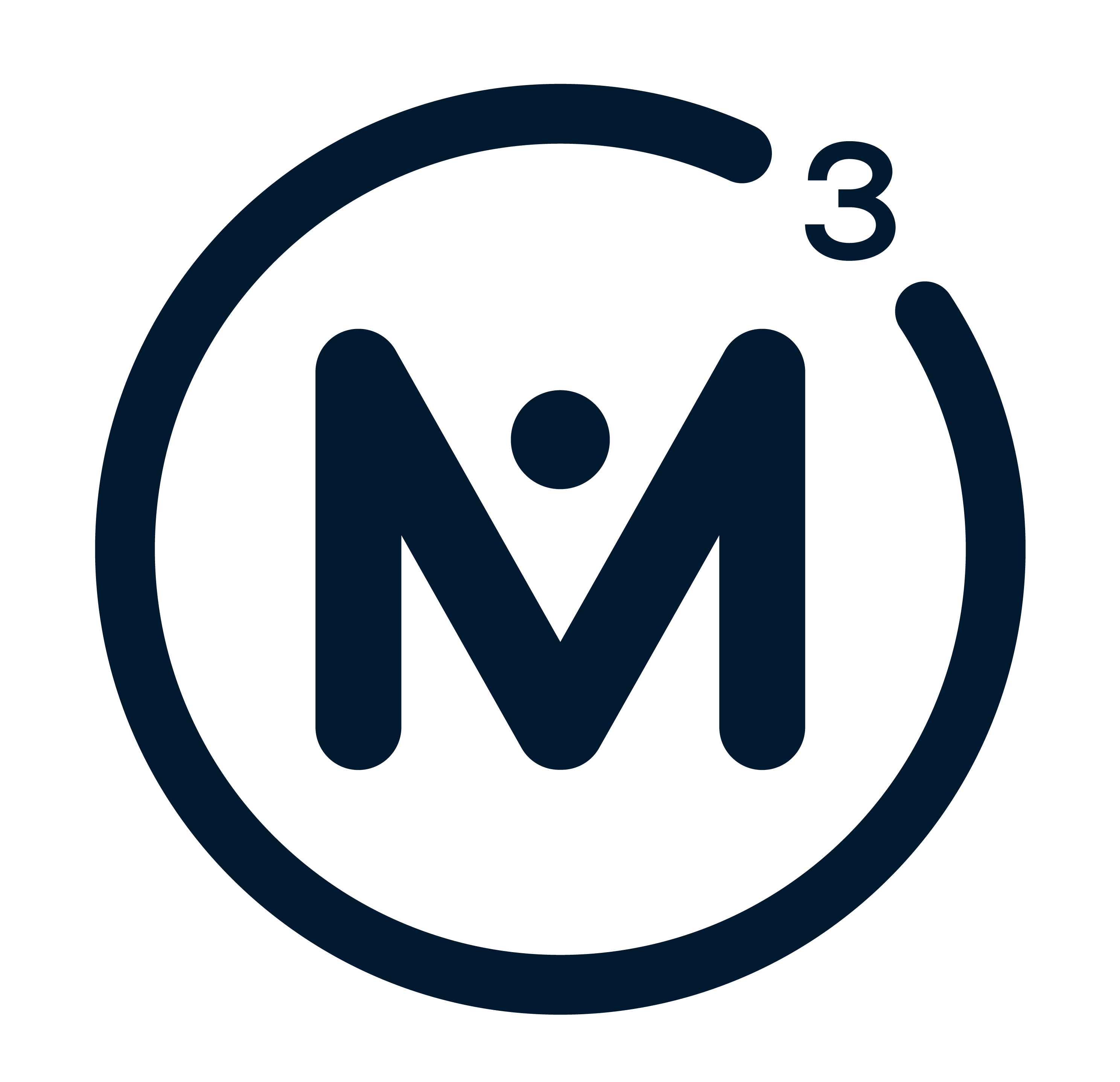
0 Comments